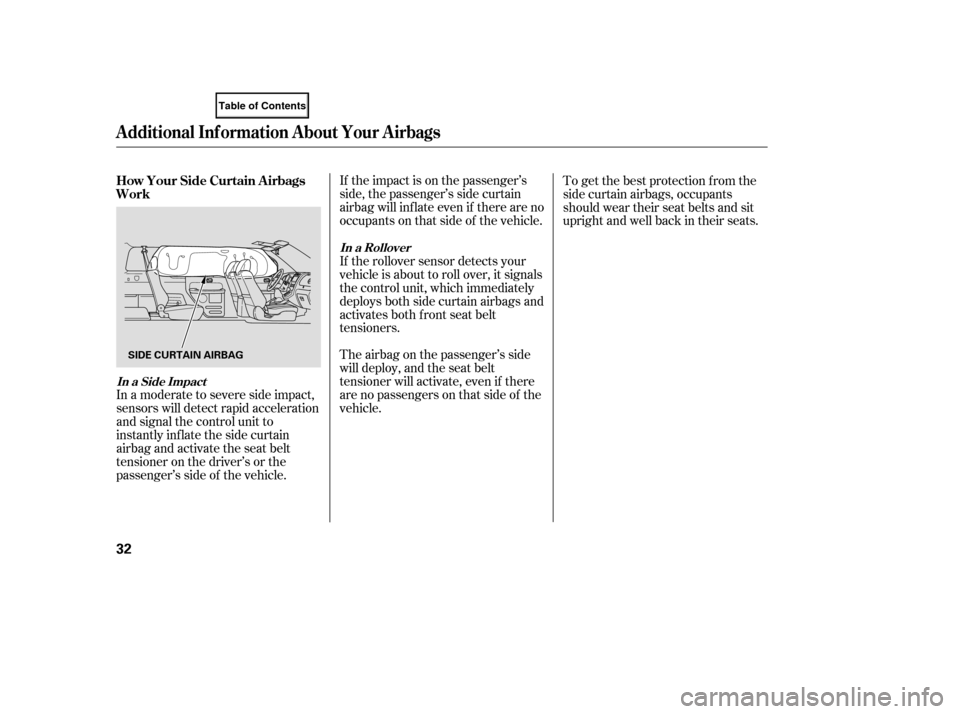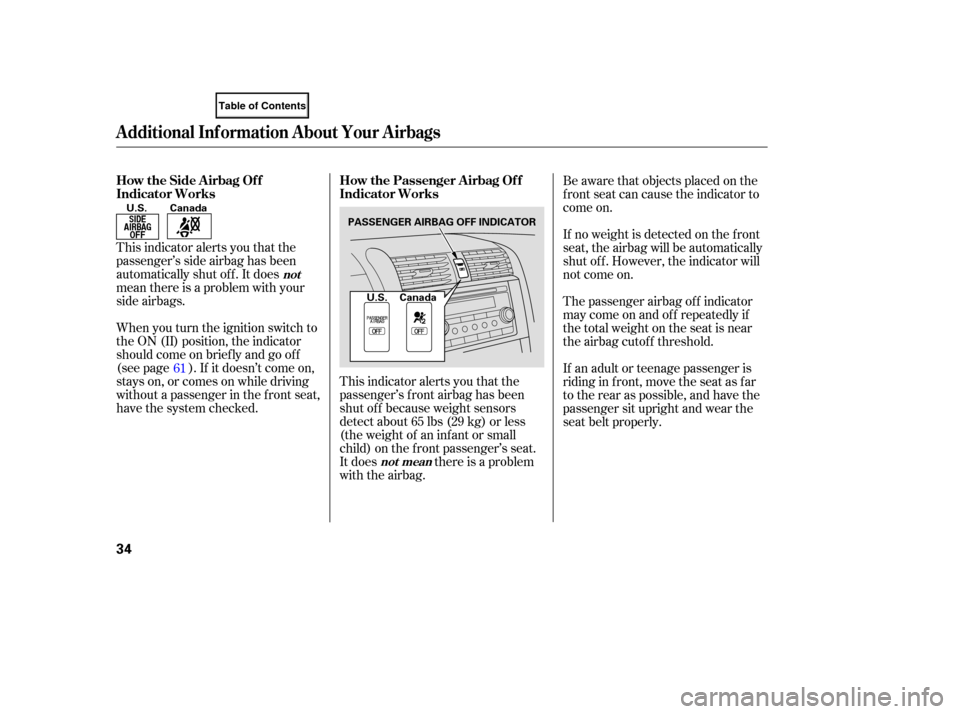sensor HONDA ELEMENT 2007 1.G User Guide
[x] Cancel search | Manufacturer: HONDA, Model Year: 2007, Model line: ELEMENT, Model: HONDA ELEMENT 2007 1.GPages: 275, PDF Size: 4.16 MB
Page 35 of 275

If the impact is on the passenger’s
side, the passenger’s side curtain
airbag will inflate even if there are no
occupants on that side of the vehicle.To get the best protection f rom the
side curtain airbags, occupants
should wear their seat belts and sit
upright and well back in their seats.
In a moderate to severe side impact,
sensors will detect rapid acceleration
and signal the control unit to
instantly inflate the side curtain
airbag and activate the seat belt
tensioner on the driver’s or the
passenger’s side of the vehicle. If the rollover sensor detects your
vehicle is about to roll over, it signals
the control unit, which immediately
deploys both side curtain airbags and
activates both f ront seat belt
tensioners.
The airbag on the passenger’s side
will deploy, and the seat belt
tensioner will activate, even if there
are no passengers on that side of the
vehicle.
How Your Side Curtain A irbags
Work
In a Side Impact
In a Rollover
Additional Inf ormation About Your Airbags
32
SIDE CURTAIN AIRBAG
Page 37 of 275

This indicator alerts you that the
passenger’s side airbag has been
automatically shut off. It does
mean there is a problem with your
side airbags.
Wh en you turn the ignition switch to
the ON (II) position, the indicator
should come on briefly and go off
(see page ). If it doesn’t come on,
stays on, or comes on while driving
without a passenger in the f ront seat,
have the system checked. This indicator alerts you that the
passenger’s f ront airbag has been
shut of f because weight sensors
detect about 65 lbs (29 kg) or less
(the weight of an inf ant or small
child) on the f ront passenger’s seat.
It does there is a problem
with the airbag.Be aware that objects placed on the
f ront seat can cause the indicator to
come on.
If no weight is detected on the f ront
seat, the airbag will be automatically
shut of f . However, the indicator will
not come on.
The passenger airbag of f indicator
maycomeonandoff repeatedlyif
the total weight on the seat is near
the airbag cutof f threshold.
If an adult or teenage passenger is
riding in f ront, move the seat as f ar
to the rear as possible, and have the
passenger sit upright and wear the
seat belt properly.
61
Additional Inf ormation About Your Airbags
How the Side Airbag Of f
Indicator Works
How the Passenger Airbag Of f
Indicator Works
not
not mean
34
Canada
U.S.
PASSENGER AIRBAG OFF INDICATOR
U.S. Canada
Page 38 of 275

If the indicator comes on with no
f ront seat passenger and no objects
on the seat, or with an adult riding
there, something may be interf ering
with the weight sensors. Look f or
and remove:Any items under the f ront
passenger’s seat.
Any object hanging on the seat or
in the seat-back pocket.
Any object, such as a f olded-down
back seat, that is touching the rear
of the seat-back.
If no obstructions are f ound, have
your vehicle checked by a dealer as
soon as possible. Your airbag systems are virtually
maintenance f ree, and there are no
parts you can saf ely service.
However, you must have your
vehicle serviced if:
Any airbag
that has deployed must be
replaced along with the control
unit and other related parts. Any
seat belt tensioner that activates
must also be replaced.
Do not try to remove or replace
anyairbagbyyourself.Thismust
be done by an authorized dealer or
a knowledgeable body shop.
Take your vehicle to an
authorized dealer as soon as
possible. If you ignore this
indication, your airbags may not
operate properly. Even if your
airbags do not inflate, your dealer
should inspect the driver’s seat
position sensor, the f ront
passenger’s weight sensors, the
f ront seat belt tensioners, and all
seat belts worn during the crash to
make sure they are operating
properly.
Airbag Service
An airbag ever inf lates.
T he SRS indicat or alert s you t o aproblem. If your vehicle has a moderat e t o
severe impact .
Additional Inf ormation About Your Airbags
Driver and Passenger Saf ety
35
Page 39 of 275

Together, airbags and
seat belts provide the best
protection.
Tampering could cause
the airbags to deploy, possibly
causing very serious injury.
If water or
another liquid soaks into the seat-
back, it can prevent the side airbag
cutof f system f rom working
properly. Improperly replacing
or covering f ront seat-back covers
can prevent your side airbags f rom
inf lating during a side impact.
This could make the
driver’s seat position sensor or the
f ront passenger’s weight sensors
inef f ective. If it is necessary to
remove or modif y a f ront seat to
accommodate a person with
disabilities, f irst contact Honda
Automobile Customer Service at
(800) 999-1009.
Additional Saf ety Precautions
Donotattempttodeactivateyour
airbags.
Do not t amper wit h airbagcomponent s or wiring f or anyreason.
Do not expose the f ront passenger’sseat-back to liquid. Do not cover or replace f ront seat -
back covers wit hout consult ingyour dealer.
Do not remove or modif y a f rontseat without consulting yourdealer.
Additional Inf ormation About Your Airbags
36
Page 64 of 275

If either of you do not fasten your
seat belt while driving, the beep er
will sound and the indicator will flash
again at regular intervals. For more
info rmation, see page .
This indicator comes on briefly when
you turn the ignition switch to the
ON (II) position. If it comes on at
any other time, it indicates a
poten tial problem with your front
airbags. This indica tor will also alert
you to a poten tial problem with your
side airbags, passenger’s side airbag
automatic cutoff system, side curtain
airbags, automatic seat belt
tensioners, driver’s seat position
sensor, or the front passenger’s
weight sensors. For more
info rmation, see page . This
indicator comes on when you
turn the ignition switch to the ON
(II) position. If it comes on at any
other time, it indicates that the
passenger’s side airbag has
automatically shut off. For more
info rmation, see page .
This indicator normally comes on for
a few seconds when you turn the
ignition switch to the ON (II)
position. If it comes on at any other
time, there is a problem with the
ABS. If this happens, have your
vehicle checked at a dealer. With
this indicator on, your vehicle still
has normal braking ability but no
an ti-lock function. For more
info rmation, see page . This
indicator comes on for a few
seconds when you turn the ignition
switch to the ON (II) position. It
remindsyouthatitistimetotake
your vehicle in for scheduled
maintenance. The maintenance main
items and sub items will be displayed
in the information display. See page
f or more inf ormation on the
maintenance minder.
This indicator goes of f when your
dealer resets it after completing the
required maintenance service.
20
34
33 162179
Instrument Panel Indicators
Side Airbag Of f Indicator
Supplemental Restraint
System Indicator Anti-lock Brake System
(A BS) IndicatorMaintenance Minder
Indicator
Inst rument s and Cont rols
61
Canada
U.S.
Page 150 of 275

In addition, the total weight of the
vehicle, all passengers, accessories,
cargo, and trailer tongue load must
not exceed the Gross Vehicle
Weight Rating (GVWR) or the Gross
Axle Weight Rating (GAWR). Both
areonalabelonthedriver’s
doorjamb.
Store or secure all items that could
be thro wn around and hurt
someone during a crash.
Be sure items placed on the floor
behind the front seats cannot roll
under the seats and interfere with
the driver’s ability to operate the
pedals, the proper operation of the
seats, or proper operation of the
sensors under the seats.
Keep the glove box closed while
driving. If it is open, a passenger could
injure their knees during a
crash or sudden stop.
Ifyoufoldtherearseatsdownor
up,orremovethem,tiedown
items that could be thro wn about
the vehicle during a crash or
sudden stop. Also, keep all cargo
below the bottom of the windows.
If it is higher, it could interfere
with the proper operation of the
side curtain airbags.
Distribute cargo evenly on the
floor of the cargo area, placing the
heaviest items on the bottom and
as far forward as possible. Tie
down items that could be thro wn
about the vehicle during a crash or
sudden stop.
If you carry large items that
prevent you f rom closing the
tailgate or the hatch, exhaust gas can enter the passenger area. To
avoid the possibility of ,followthe
instructions on page .
If you carry any items on a roof
rack,besurethetotalweightof
the rack and the items does not
exceed 165 lbs (75 kg).
If you use an accessory roof rack,
the roof rack weight limit may be
lower. Ref er to the inf ormation that
came with your roof rack.
Theseparationnetcanbeusedto
hold back sof t, lightweight items
stored in the cargo area. Heavy
items should be properly secured on
the f loor of the cargo area. The net
may not prevent heavy items f rom
being thrown f orward in a crash or a
sudden stop. 54
Carrying Items in the Passenger
Compartment Carrying Cargo in the Cargo A rea
or on a Roof Rack carbon
monoxide poisoning
Optional Separation Net
Carrying Cargo
Bef ore Driving
147
Page 166 of 275

Your vehicle is equipped with a tire
pressure monitoring system (TPMS)
that turns on every time you start the
engine and monitors the pressure in
your tires while driving. Each
tire, including the spare, should
be checked monthly when cold and
set to the recommended inflation
pressure as specified in the vehicle
placard and this owner’s manual (see
page ).
Although your tire pressure is
monitored, you must manually check
thetirepressuresmonthly.
If you think you can saf ely drive a
short distance to a service station,
proceed slowly, and inf late the tire to
the recommended pressure shown
on the driver’s doorjamb.
When the tire pressure monitoring
system warning indicator is on, one
or more of your tires is signif icantly
under-inf lated. You should stop and
check your tires as soon as possible,
and inflate them to the proper
pressureasindicatedonthevehicle’s
tire inf ormation placard.
If the tire is f lat, or if the tire
pressure is too low to continue
driving, replace the tire with the
compact spare tire.
Each tire has its own pressure
sensor. If the air pressure of a tire
becomes signif icantly low, the
sensor in that tire immediately sends
a signal that causes the low tire
pressure indicator to come on. After inflating the tire(s) to the
proper pressure, the warning
indicator will remain on until the
vehicle is driven at a speed more
than 25 mph (40 km/h).
Driving on a signif icantly under-
inf lated tire causes the tire to
overheat and can lead to tire failure.
Under-inf lation also reduces f uel
efficiency and tire tread life, and may
af f ect the vehicle’s handling and
stopping ability. 245
Tire Pressure Monitoring System (TPMS)
Low Tire Pressure
Indicator
Driving
163
Page 167 of 275

Each wheel is equipped with a tire
pressure sensor mounted inside the
tire behind the valve stem. You must
use TPMS specific wheels. It is
recommended that you always have
your tires serviced by your dealer or
qualified technician.
After you replace the flat tire, the
low tire pressu re indicator stays on.
This is norm al; the system is not
monitoring the spare tire pressure.
Manually check the spare tire
pressure to be sure it is correct.
Never use a puncture-repairing agent
in a flat tire. If used, you will have to
replace the tire pressure sensor.
Havetheflattirerepairedbyyour
dealer as soon as possible.
This
indicator comes on and stays on
if there is a problem with the tire
pressure monitoring system.
If you see this message, the system
is off and is not monitoring the tire
pressures. Have the system checked
by your dealer as soon as possible.
If you have a f lat tire, the low tire
pressure indicator will come on.
Replace the flat tire with the
compact spare tire (see page ). 218As required by the FCC:
This device complies with Part 15 of theFCC rules. Operation is subject to thef ollowing two conditions: (1) This devicemay not cause harmf ul interf erence, and(2) this device must accept anyinterf erence received, includinginterf erence that may cause undesiredoperation.
Changes or modif ications not expresslyapproved by the party responsible f orcompliance could void the user’sauthority to operate the equipment.
This device complies with IndustryCanada Standard RSS-210.Operation is subject to the f ollowing twoconditions: (1) this device may not causeinterf erence, and (2) this device mustaccept any interf erence that may causeundesired operation of the device.
Tire Pressure Monitoring System (TPMS)
Tire Pressure Monitoring
System (T PMS) Indicator
Changing a T ire with T PMS
164
Page 255 of 275

The PGM-FI system uses sequential
multiport f uel injection. It has three
subsystems: air intake, engine
control, and f uel control. The
powertrain control module (PCM) in
automatic transmission vehicles or
the engine control module (ECM) in
manual transmission vehicles uses
various sensors to determine how
much air is going into the engine. It
then controls how much f uel to inject
under all operating conditions.The emissions control systems are
designed and certif ied to work to-
gether in reducing emissions to
levels that comply with the Clean Air
Act. To make sure the emissions
remain low, you should use only new
Honda replacement parts or their
equivalent f or repairs. Using lower
qualitypartsmayincreasethe
emissions f rom your vehicle.
The exhaust emissions controls
include three systems: PGM-FI,
ignition timing control, and three
way catalytic converter. These three
systems work together to control the
engine’s combustion and minimize
the amount of HC, CO, and NOx that
comes out the tailpipe. The exhaust
emissions control systems are
separate f rom the crankcase and
evaporative emissions control
systems. The emissions control systems are
covered by warranties separate from
the rest of your vehicle. Read your
warranty manual for more informa-
tion.
The three way catalytic converter is
in the exhaust system. Through
chemical reactions, it converts HC,
CO, and NOx in the engine’s exhaust
to carbon dioxide (CO ), nitrogen
(N ), and water vapor. This system constantly adjusts the
ignition timing, reducing the amount
of HC, CO, and NOx produced.
2
2
Exhaust Emissions Controls Replacement PartsPGM-FI System
Three Way Catalytic Converter
Ignit ion T iming Cont rol Syst em
Emissions Cont rols
252